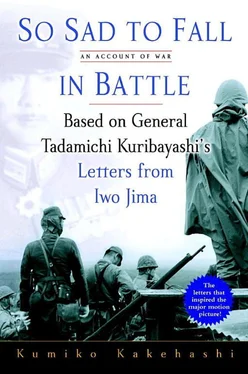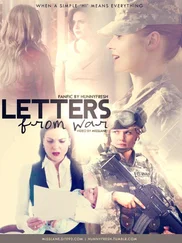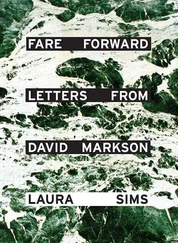He thanks his wife formally like this and then continues:
There were many occasions when I should have expressed my gratitude to you—I had the means to do so after all—but I thought that the feeling of gratitude within me was enough by itself, so I did not make the effort to say “Thank you.” It is something I regret deeply. Do not think badly of me. I hope you will forgive me.
When he left for the front, Egawa told Mitsue he was sure he’d “make it back alive,” but it is clear that he meant this letter to be his final message.
Fully aware that he was going to die, he ends his letter with the words: “Fight the good fight!” And Mitsue proved herself worthy of the trust her husband had placed in her. For sixty years after the war ended, she lived on, “fighting the good fight,” just like all the other women who lost their husbands in that war.
A FEW DAYS AFTER meeting Egawa Mitsue, I came across the final message of a young soldier who had been on Iwo Jima; it had been published in the bulletin of the Association of Iwo Jima.
Egawa and Kuribayashi both wrote letters that were implicit “final messages” to their families, but this one actually bore the title “Final Message” at the head of the page. Written on unlined white paper, the characters neatly aligned and the brushwork perfect, it looked the way one feels a final message ought to look. I felt myself drawn to it—the stylized characters like those in a calligraphy textbook, and the youthful determination it exuded, so different from anything Kuribayashi or Egawa wrote.
The Association of Iwo Jima receives numerous inquiries about the personal effects of dead Japanese soldiers that American soldiers took back home with them from Iwo Jima. These might be army-issued notebooks, diaries, Rising Sun flags with good-luck messages written on them, or family photographs. Many such personal effects have been returned to the families of the dead.
This final message appeared in March 2004 in the “Does Anybody Know Anything About This?” section of the association’s bulletin. A photocopy of the final message had been sent to the association in September of the year before.
Final Message
As one who was given life in order to serve the emperor, I was always ready for my corpse to lie in the field of battle. It is my long-cherished desire as a soldier.
I go to my death happily and with a feeling of calm. But the shame of being unable to perform my duty satisfactorily is unendurable.
My honorable father and mother, for more than twenty years I have caused you great bother; under your warm guardianship you raised me to be a fine man over five shaku in height, and it is truly inexcusable that I am unable now to do anything for you in return. All I can do is express my warmest thanks.
The young man goes on to say that he wants his 200 yen’s worth of savings to be spent “for the country,” tells them how his personal effects should be dealt with, sends his regards to his relatives and neighbors, and prays that his native village will thrive. He writes about how things were when he left for the front, which suggests that he did not compose the message in advance, but after getting to Iwo Jima.
In conclusion, I would like to wish good health and long life to you, Father and Mother, and to my big brothers and sisters Torao, Kei, Eizô, Tadashi, Otaka, Suehara, and to Tatsumi, Fumiko, and Tatsuko. Father and Mother, you are old now, so please take care of yourselves.
My only regret is that I was never able to see the splendid new house that you both worked so hard to build, Father and Mother. I am sorry about that. For the rest, I have no regrets.
What was the young soldier thinking as he wrote the names of all the members of his family? The first half of his final message is typically soldierly and stiff, but the part that follows the names of his six older and three younger siblings shows some of the uncertainty one would expect from a young man in his twenties.
By the time the soldier wrote this message there were probably no more planes to deliver it to his family. Did he have his final message on him as he fought in the battle? Even after his body rotted away, his final message did not molder away into the earth of Iwo Jima but reaches out across six decades.
No relative has stepped forward to claim it. Still undelivered, his final message ends like this:
There is more that I would like to write, but I am so overwhelmed by emotion that I cannot remember what it was.
Best Wishes. Tatsuo To my father and mother
—
THE AMERICANS GAVE MOUNT SURIBACHI THE CODE NAME “Hot Rocks.” Suribachi was a dormant volcano that only spat out the odd lick of steam here and there; nonetheless, quite a few marines were worried that the tremendous bombardment they were subjecting it to could reawaken it and provoke a volcanic eruption.
It was 10:31 a.m. on D-day plus four (February 23) that the Stars and Stripes first flew from the summit of Hot Rocks. The flag was a little on the small side—just 70 centimeters high by 135 centimeters wide—but the island was small enough that nearly all the marines there could see it. In their joy at having captured the mountain that symbolized the island, some cheered, some wept, and others waved their helmets in the air and whistled. The ships out at sea all sounded their horns together.
The wild enthusiasm of the American forces was in proportion to the massive damage they had suffered in the days between the landing and that moment. After D-day, which produced more casualties than they had expected, they had occupied Chidori Airfield and then divided the jobs of taking Mount Suribachi and the main Japanese defensive position northeast of the island. The Japanese continued to offer stiff resistance and the Americans were able to advance only from 50 to 500 meters a day. Many of the frontline officers were killed in action, and it was only on D-day plus three that the Americans were finally able to concentrate on taking Mount Suribachi, though it had seemed to be right there in front of them on the beach where they had landed.
The photograph of the six soldiers raising the flag that was featured on the front pages of newspapers and went on to be turned into a stamp and a bronze statue was not taken at this time, because the flag was actually raised on the summit of Suribachi on two separate occasions.
Immediately after the first flag had been raised, someone wanted to save it for a souvenir. That someone was Lieutenant Colonel Chandler W. Johnson, commanding officer of the Fifth Division, 28th Regiment, Second Battalion, to which the marines who went up the summit of Suribachi belonged. As they were about to start their ascent, Johnson handed one of them a flag he had brought ashore, “If you get to the top, put it up.” He was thus the originator of the whole episode.
Johnson wanted to keep the first historic flag safe and raise a substitute in its place. And anyway, wouldn’t a bigger flag be better? He therefore tracked down a second flag and had that taken up to the summit. The new flag measured 140 centimeters by 245 centimeters.
In this way, the first flag was taken down and a second flag was hoisted in its place. The celebrated photograph by Joe Rosenthal, an AP photographer, captured this second flag raising. His photograph not only reached Guam faster than the pictures of the first flag raising taken by the marine press corps, but had such magnificent composition and lighting that it ended up being featured in hundreds of newspapers.
Everything about the photograph—from the distribution of the soldiers to the way the flag was waving—was so perfect that a rumor circulated that the photographer had staged the whole thing. The truth was that Rosenthal had gotten there late and, barely in time for the second hoisting, had clicked the shutter in considerable haste.
Читать дальше












